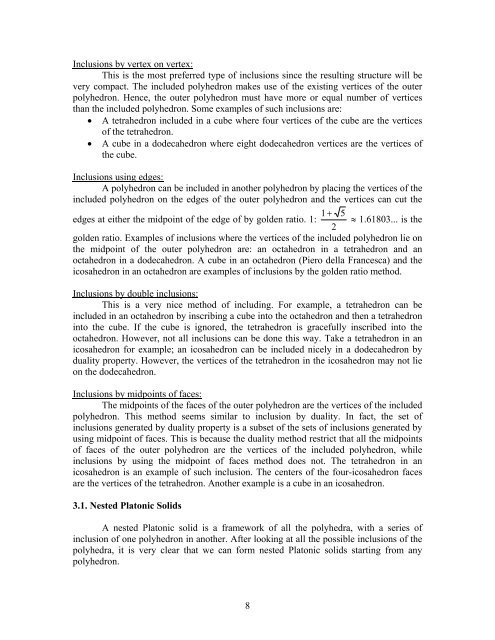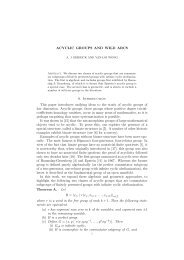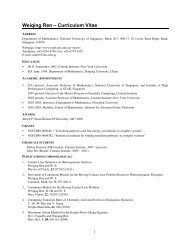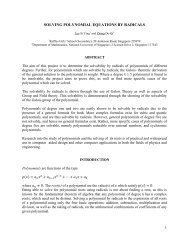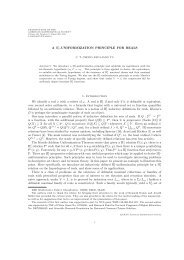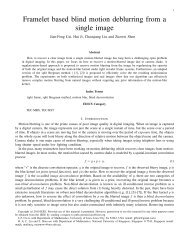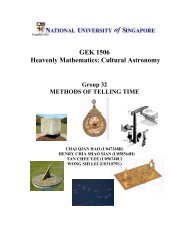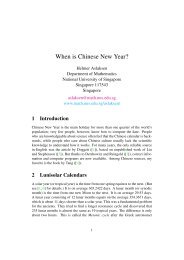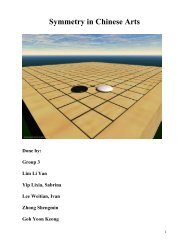Polyhedra - Department of Mathematics
Polyhedra - Department of Mathematics
Polyhedra - Department of Mathematics
You also want an ePaper? Increase the reach of your titles
YUMPU automatically turns print PDFs into web optimized ePapers that Google loves.
Inclusions by vertex on vertex:<br />
This is the most preferred type <strong>of</strong> inclusions since the resulting structure will be<br />
very compact. The included polyhedron makes use <strong>of</strong> the existing vertices <strong>of</strong> the outer<br />
polyhedron. Hence, the outer polyhedron must have more or equal number <strong>of</strong> vertices<br />
than the included polyhedron. Some examples <strong>of</strong> such inclusions are:<br />
• A tetrahedron included in a cube where four vertices <strong>of</strong> the cube are the vertices<br />
<strong>of</strong> the tetrahedron.<br />
• A cube in a dodecahedron where eight dodecahedron vertices are the vertices <strong>of</strong><br />
the cube.<br />
Inclusions using edges:<br />
A polyhedron can be included in another polyhedron by placing the vertices <strong>of</strong> the<br />
included polyhedron on the edges <strong>of</strong> the outer polyhedron and the vertices can cut the<br />
1+ 5<br />
edges at either the midpoint <strong>of</strong> the edge <strong>of</strong> by golden ratio. 1: ≈ 1.61803... is the<br />
golden ratio. Examples <strong>of</strong> inclusions where the vertices <strong>of</strong> the included polyhedron lie on<br />
the midpoint <strong>of</strong> the outer polyhedron are: an octahedron in a tetrahedron and an<br />
octahedron in a dodecahedron. A cube in an octahedron (Piero della Francesca) and the<br />
icosahedron in an octahedron are examples <strong>of</strong> inclusions by the golden ratio method.<br />
Inclusions by double inclusions:<br />
This is a very nice method <strong>of</strong> including. For example, a tetrahedron can be<br />
included in an octahedron by inscribing a cube into the octahedron and then a tetrahedron<br />
into the cube. If the cube is ignored, the tetrahedron is gracefully inscribed into the<br />
octahedron. However, not all inclusions can be done this way. Take a tetrahedron in an<br />
icosahedron for example; an icosahedron can be included nicely in a dodecahedron by<br />
duality property. However, the vertices <strong>of</strong> the tetrahedron in the icosahedron may not lie<br />
on the dodecahedron.<br />
Inclusions by midpoints <strong>of</strong> faces:<br />
The midpoints <strong>of</strong> the faces <strong>of</strong> the outer polyhedron are the vertices <strong>of</strong> the included<br />
polyhedron. This method seems similar to inclusion by duality. In fact, the set <strong>of</strong><br />
inclusions generated by duality property is a subset <strong>of</strong> the sets <strong>of</strong> inclusions generated by<br />
using midpoint <strong>of</strong> faces. This is because the duality method restrict that all the midpoints<br />
<strong>of</strong> faces <strong>of</strong> the outer polyhedron are the vertices <strong>of</strong> the included polyhedron, while<br />
inclusions by using the midpoint <strong>of</strong> faces method does not. The tetrahedron in an<br />
icosahedron is an example <strong>of</strong> such inclusion. The centers <strong>of</strong> the four-icosahedron faces<br />
are the vertices <strong>of</strong> the tetrahedron. Another example is a cube in an icosahedron.<br />
3.1. Nested Platonic Solids<br />
A nested Platonic solid is a framework <strong>of</strong> all the polyhedra, with a series <strong>of</strong><br />
inclusion <strong>of</strong> one polyhedron in another. After looking at all the possible inclusions <strong>of</strong> the<br />
polyhedra, it is very clear that we can form nested Platonic solids starting from any<br />
polyhedron.<br />
8<br />
2


